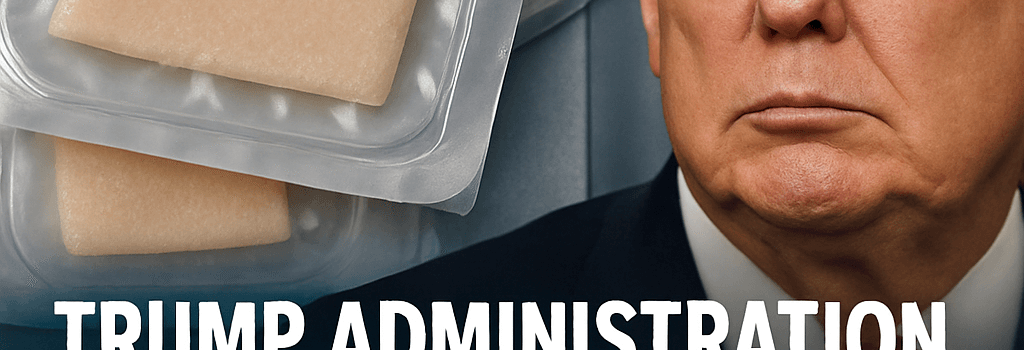Trump Administration Caps Skin Substitute Prices After Medicare Spike

Last year, Medicare expenditures on advanced skin substitutes soared to over $10 billion—a 40-fold increase from 2019’s $250 million. These products, often derived from processed human tissue (dried placentas, infant foreskin allografts) or synthetic matrices, routinely fetched list prices exceeding $21,000 per square inch. Individual patient bills have topped $1 million, sometimes for those without visible wounds. After twice delaying a Biden-era pricing reform, the Trump administration has now proposed a hard cap to curb this runaway spending.
Background: Explosive Growth in Skin Substitute Spending
Medicare’s current reimbursement model created a perverse incentive. Under the Pass-Through Payment Status for new medical technologies—and the “ASP+6%” (Average Sales Price plus 6%) rule for physician-administered products—manufacturers set their own launch prices, driving up Medicare’s six-month initial payment rate to match. Post-launch, providers claim the discounted rate they actually paid, but many manufacturers simply introduce nearly identical new products to reset the six-month clock and preserve high reimbursements.
Key Pricing Loopholes
- New Product Pass-Through: CMS granted new skin substitutes temporary pass-through status, allowing 100% add-on reimbursement.
- J-Code Pricing: Unique HCPCS J-codes let manufacturers bundle administration fees into the device cost, inflating overall charges.
- ASP+6% Margin: Providers received a 6% markup over ASP, incentivizing use of higher-priced products.
Regulatory Hurdles and FDA Approval Pathways
Most skin substitutes enter the market via FDA’s 510(k) clearance, demonstrating substantial equivalence to predicate devices rather than exhaustive clinical trials. True PMA (Premarket Approval)—which requires Phase I–III studies—remains rare in this category. Meanwhile, tissue-based products must comply with 21 CFR Part 1271 Good Tissue Practices, including:
- Donor screening and serology testing (HIV, HBV, HCV).
- Aseptic processing and viral inactivation validation.
- Sterility assurance level (SAL) 10–6 for implantable grafts.
Manufacturing and Supply Chain Considerations
Allograft producers rely on accredited tissue banks, intricate logistics, and cold‐chain management. Key cost drivers include:
- Harvesting and donor testing—perishable human tissue demands rapid processing.
- Lyophilization or cryopreservation—equipment and energy costs to stabilize cells vs. synthetic polymer scaffolds.
- Quality systems—ISO 13485 certification, batch release testing, bioburden and endotoxin assays.
Smaller startups are experimenting with 3D‐bioprinted skin, decellularized ECM scaffolds, and recombinant collagen matrices, aiming to lower costs and improve reproducibility.
New CMS Price Cap Proposal
After delaying the Biden-era policy twice, the administration’s April proposal sets a flat reimbursement of $809 per square inch starting January 2026. The plan narrows Medicare eligibility to products with Level I–II evidence showing superiority over standard gauze or foam dressings in randomized controlled trials.
“We are cracking down on abuse that drives up costs and ensures beneficiaries receive clinically proven therapies,” said CMS Administrator Mehmet Oz.
The Advanced Medical Technology Association (AdvaMed) warned that the cap “may not cover production costs”, potentially limiting patient access. However, independent analysts project manufacturers can realign portfolios toward evidence‐based products and larger volume at lower price points.
Economic Impact and Market Outlook
According to MedPAC, instituting value-based pricing could cut annual Medicare spending by $6–8 billion within five years. Commercial insurers already restrict coverage to PMA-approved or peer-reviewed devices, driving many providers to forgo unproven substitutes.
Expert Analysis and Future Innovations
“Aligning reimbursement with demonstrated clinical benefit is essential,” stated Dr. Angela Chen, health economist at the Brookings Institution. “We expect a migration toward multifunctional scaffolds with antimicrobial peptides and sustained‐release growth factors, priced competitively under the new CMS cap.”
Innovations on the horizon include AI-driven wound imaging to personalize dressing choice, bioprinting customized grafts from autologous cells, and hybrid hydrogels integrating silver nanoparticles for infection control. Such advances promise to reshape the skin substitute market toward higher efficacy and cost-effectiveness.
Conclusion
The proposed $809 per square inch cap marks a turning point in Medicare’s effort to rein in unrestrained skin substitute spending. While manufacturers and providers adapt, beneficiaries stand to benefit from a more transparent, evidence‐driven marketplace and sustainable pricing aligned with clinical outcomes.